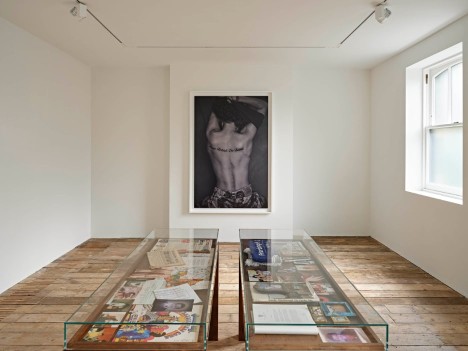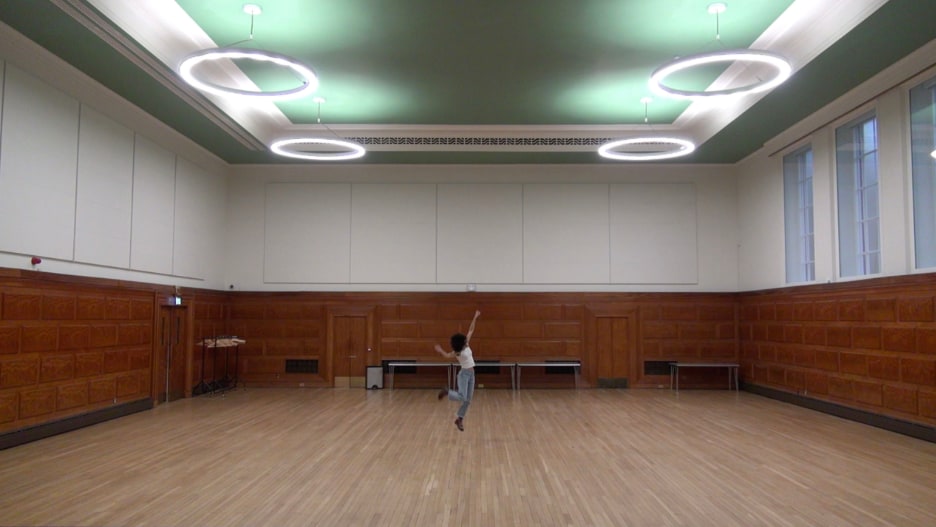Almanac Projects Writer in Residence
Rene Matic
Leanne Petersen responds to Rene Matic’s practice in dialogue with Black Cultural Archives’ collection

Rene Matić, ‘upon this rock’, South London Gallery
‘A citizen who describes themselves as “Black, Black British, Caribbean or African” is then only allowed to state that their ethnic group is also “Caribbean, African or other Black”. There is no option to be Black and English.’[1] – David Lammy, Labour MP.
Earlier this year, Almanac Projects, Art Monthly and the Black Cultural Archives in Brixton, invited me to be their writer in residence and respond to the practice of British artist Rene Matić.
Born in Peterborough to an English mother and Irish-St Lucian father in 1997, Matić investigates their identity and experiences as a queer mixed-race womxn of the black British diaspora to expose structures and ideologies surrounding Britishness, nationalism and blackness. Through a multidisciplinary practice, comprising photography, textile, film and prose, the artist looks at Britain’s complex and often paradoxical history concerning race from the postwar era to the present day.
In 1948 the British Nationality Act saw all those born under British colony rule – the commonwealth – granted British citizenship. A statute which led to approximately 300,000 West Indians arriving in Britain between 1948 and 1964 – many of whom were answering the country’s call for workers to rebuild the economy, operate public transport and drive the newly created NHS after the Second World War. The UK’s Ministry of Information published literature throughout the 1950s which suggests this was to be a planned and peaceful integration, with titles such as, ‘What can be done to improve your relations between white and coloured people?’, ‘Your Neighbour from the West Indies’ and ‘How-to live-in Britain: A handbook for students from overseas’.[2] The UK’s image was seemingly that of a progressive and democratic nation – as demonstrated in the propagandist pamphlets found in the Black Cultural Archives. However, such claims of inclusion ring hollow as only a few years earlier the stationing of African American troops in rural parts of Britain at the end of the Second World War heard then Labour MP Herbert Morrison issue a candid warning against interracial sex, claiming that the proliferation of mixed-race children would become the ubiquitous social issue. Lucy Bland, author of the 2019 study Britain’s ‘Brown Babies’: The stories of children born to black GIs and white women in the Second World War, explains that ‘to avoid the birth of such “half-caste children” – as official documents labelled this group – the government was keen to discourage the mixing of black troops and local white women, proposing that white women should not walk out, dance, or drink with them [black men]’.
The paired threat of miscegenation and a non-white Britain meant Morrison’s rhetoric became an open invitation for members of the public to further police the lives of black men and women. Paul Gilroy outlines an example of this in his 1987 book There Ain’t No Black in the Union Jack, which shares the account of a young Jamaican man named Enrico Sennett, an entertainer hired to perform at white working-class dance halls in the early 1950s. When Sennett moves to the south of England for work, however, he is unable to find black women dance partners and so instead performs with white dancers. On one occasion Sennett recalls how the crowd became hostile, asking him to leave from fear that more white women will be encouraged to dance with black men.
Such prejudices led to the methods of exclusion which became known as the Colour Bar. As Ron Ramdin observes in The Making of the Black Working Class in Britain, ‘whites were hypersensitive’ to black immigrants, which led to them being ‘classified’, specifically an ‘image of a black person was built up as an intruder.’[3] While racial segregation never became UK law, the Colour Bar prevented many from securing employment, accessing safe and clean housing, and its effects spilled across social spaces, including pubs and clubs.
It is paradoxical then, that music and dance would become one of the main political tools adopted in the attempt to soothe racial tensions. Set in the London borough of Lambeth, one such attempt to ease social anxieties and fraught relations between blacks and whites in the area was the 1955 No Colour Bar Dance. Spearheaded by the West Indian Committee and then mayor of Lambeth, this occasion saw 360 ‘representatives’ from the local community – half of whom were black and the other white, gather for an evening of music and dance at the Lambeth Assembly Hall in Brixton.
A British Pathé news segment ripped from YouTube entitled ‘No Colour Bar’ Dance, hears the voice-over declare that ‘everything was 50/50, half the guests were English and half West Indian, and so was the music’, and that ‘the rhythm of the mambo was doing its bit towards racial union … on a dance floor in the town hall, the people of Lambeth offered a hand of welcome to their coloured neighbours’. South London Press described the evening as a ‘Tropical Night in the Assembly’. ‘Exotic, Barbaric, perhaps?’ the reporter quips, before liberally recounting the evening and adding that ‘the MC did try to interest us in old English measures like the “Barn Dance” and “Boomps-A-Daisy”, but one was too complicated and the other shocked my coloured girl partner, who giggled helplessly when we had to smack hands, knees and posteriors’.[4]

Rene Matić, we give a lead to britain, 2020
Matić’s 2020 video work we give a lead to britain pays reverence to the black and white bodies who attended the 1955 No Colour Bar Dance. Filmed inside the empty Lambeth Assembly Hall during the Covid-19 pandemic, the artist dances in slow motion to the distorted sound of a Northern Soul record. In a recent interview, Matić shared that ‘dancing alone looks and feels like a fight with the self; the body becomes in discussion with itself and the space that it is in’.[5]
Matić’s performance of hard and sharp gestures found in Northern Soul, Ska (skanking) and Ballroom Music (voguing) draws attention to what the artist describes as an internal struggle, elucidating the nuances found in these music genres that share historical connections to black and white cultural exchanges. In Brown Girl in the Art World III, 2019, Matic dances outside a Cornish pub decorated with England’s Cross of Saint George flags, the work similarly examines the idea of taking up space in order to confront the insidious nature of the white gaze.
Matić’s chosen imagery of music and dance also includes fashion and textile. This enables them to interrogate heteronormative archetypes such as those shown in the Pathé clip of the 1955 dance – with men dressed in suits and the women in fitted dresses and heels. Often dressed in black leather boots and blue denim, the virility of Matic’s attire symbolises a countercultural aesthetic which serves to unravel how class divisions in postwar Britain remain critically influential in the development of numerous identities of working-class and youth cultures across eras. As Dick Hebdige notes in the text Subculture: The Meaning of Style, ‘the challenge to hegemony which subcultures represent is not issued directly by them. Rather it is expressed obliquely, in style.’[6].
Speaking in 2014 at the New School University in New York, bell hooks, the late author and social activist, described the term queer ‘not as being about who you’re having sex with – that can be a dimension of it – but queer as being about the self that is at odds with everything around it and has to invent and create and find a place to speak and to thrive and to live.’[7] In using their experiences as a marginalised body which is continually informed by a queer existence, Matić disrupts normative assumptions of British society through a connection to skinhead subculture rooted in the union of West Indian and white working-class cultures. Skinhead style has since been adopted by right-wing extremists to become the now dominant image of white supremacists.
In Born British, Die British, 2020, Matić is inked by the renowned skinhead tattooist Lal Hardy with this titular phrase synonymous with white supremacists. Anne Wilson explains in Mixed Race Children that ‘the most direct threat posed by mixed-race children is that of blurring physical categories upon which white status and power depend’.[8] By capturing this phrase on their skin, Matić arguably inserts themselves into the very nation which seeks to invalidate their existence.
It is clear that Matić’s practice does not allow for straightforward interpretations, their work is crucial for an improved understanding of Britain’s polygonal identities. Cultural theorists, historians, curators and critics alike have all grappled in the past with issues surrounding the terminology placed upon black and marginalised bodies. For instance, Dr Susan Benson writing in the 1980s explains that to be mixed-raced was often thought of as being ‘in-between races’, and that the term ‘coloured’ was often employed to describe these individuals. She adds that the term black was later employed to describe those who were mixed-race in order to provide them an identity with context.”[9]
The relationship between those deemed ‘black’, ‘brown’ or ‘other’ and that of nationality in Britain requires further attention, current understanding of multicultural identity is arguably incomplete and limited. Such confined definitions of race and ethnicity will no longer serve our past or present. An acknowledgement for individual’s identities can no longer be lazily covered with such umbrella terms and needs to encompass gender, race, ethnicity and experiences. Therefore, any absence of African diasporic voices and exchanges with Britain must be documented, compensated for and counterbalanced. Heritage sites such as the Black Cultural Archives must be adequately preserved and funded as this is a shared history – a British history. The implications of such actions will not only determine how we continue to recall these moments within its histories, but how they shape the way in which future generations identities are constructed by them and how they choose to present themselves in the world.
Leanne Petersen is a writer and independent curator, she recently produced the Thomas J Price Windrush Art Commission in Hackney, London.
Leanne Petersen’s text was commissioned by Almanac Projects in collaboration with Art Monthly and the Black Cultural Archives as part of their open call Writer in Residence 2022 initiative. The project was supported by Arts Council England.
[1] Mr. David Lammy, ‘Why does the state say you can be Black and Welsh but not Black and English?’, University of Southampton, 2021.
[2] ‘Obviously we must dispel our ignorance of each other and that means getting to know each other. It is very important to get to know about each other, about our different ways and habits and standards and so on, but it is much more important for an Englishman to get to know a West Indian by his Christian name of choice. We must break the “silence Barrier” which is the great divide. The onus is on the English, however as we are used to it and the West Indians are not. They speak readily to strangers we do not.’ From the conference report Strangers in our midst, convened by the Leeds International council, 1955, p7
[3] Ron Ramdin, The Making of the Black Working Class in Britain, 2017, p189–194.
[4] South London Press, February 1955.
[5] Charlie Mills, interview with Rene Matić, Floor Magazine, 2021.
[6] Dick Hebdige, Subculture: The Meaning of Style, 1979, p17.
[7] bell hooks, Are You Still a Slave? Liberating the Black Female Body, Eugene Lang College, 2014.
[8] Anne Wilson, Mixed Race Children: A Study of Identity, 1987, p7.
[9] Susan Benson, Ambiguous Ethnicity: Interracial Families in London, 1981, p134–138.








